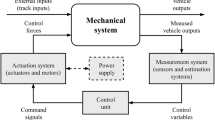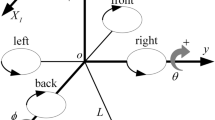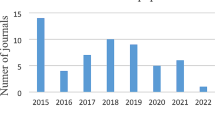Abstract
In this paper, the dynamic behavior of the nonlinear full-car model having active suspensions with nine degrees of freedom including driver, passenger seats and antilock braking system (ABS) is analyzed. The comfort analysis of a driver and passengers of the full car with active suspension model including all forms of nonlinearities is very rare in the literature. The literature also lacks the comfort analysis of the driver and passengers, while the car accelerates and decelerates during cornering. The nonlinearities in the proposed model include the dry friction nonlinearities of the suspension dampers and the geometric nonlinearities of the four corners of the car chassis. Modified adaptive NeuroFuzzy Takagi–Sugeno–Kang (NFTSK) control strategies are presented for the vehicle active suspension control to improve the ride quality, road holding capability and vehicle stability. Separate control strategy is used for ABS to avoid wheel locking and slipping for providing better road–wheel contact. The paper also investigates the coordination of active suspensions and ABS to further enhance the performance of the ABS control. To validate the performance of the proposed intelligent control strategies, the response of the vehicle nonlinear model due to road irregularities is evaluated using various performance indexes. The results are then compared with passive control to verify the performance of modified adaptive NFTSK control.
Similar content being viewed by others
References
Hrovat D.: Survey of advanced suspension developments and related optimal control applications. Automatica 33(10), 1781–1817 (1997)
Els P.S., Theron N.J., Uys P.E., Thoresson M.J.: The ride comfort vs handling compromise for off-road vehicles. J. Terramech. 44(4), 303–317 (2007)
Rahmi G.: Active control for seat vibrations of a vehicle model using various suspension alternatives. Turk. J. Eng. Environ. Sci. 27, 361–373 (2003)
Yagiz N., Hacioglu Y.: Backstepping control of a vehicle with active suspensions. Control Eng. Pract. 16(12), 1457–1467 (2008)
Oprea, R.A.; Mihailescu, M.: Oscillations of the vehicles with dry friction damping. SISOM 2011 and Session of the Commission of Acoustics, Bucharest (2011)
Alleyne A., Hedrick J.K.: Nonlinear adaptive control of active suspensions. IEEE Trans. Control Syst. Technol. 3(1), 94–101 (1995)
Zadeh L.A.: Fuzzy sets. Inf. Control 8(3), 338–353 (1965)
Yagiz N., Hacioglu Y., Taskin Y.: Fuzzy sliding-mode control of active suspensions. IEEE Trans. Ind. Electron. 55(11), 3883–3890 (2008)
Li H. et al.: Adaptive sliding-mode control for nonlinear active suspension vehicle systems using T–S fuzzy approach. IEEE Trans. Ind. Electron. 60(8), 3328–3338 (2013)
Eski I., Yildirim S.: Vibration control of vehicle active suspension system using a new robust neural network control system. Simul. Model. Pract. Theory 17(5), 778–793 (2009)
Cao J., Liu H., Li P., Brown D.J.: State of the art in vehicle active suspension adaptive control systems based on intelligent methodologies. IEEE Trans. Intell. Transp. Syst. 9(3), 392–405 (2008)
Sun, P.-Y.; Chen, H.: Multiobjective output-feedback suspension control on a half-car model. In: Proceedings of 2003 IEEE Conference on Control Applications, CCA 2003, vol. 1 (2003)
Kruczek, A.; Stribrsky, A.: A full-car model for active suspension-some practical aspects. In: Proceedings of the IEEE International Conference on Mechatronics ICM’04 (2004)
Khan L., Qamar S., Khan M.U.: Comparative analysis of adaptive NeuroFuzzy control techniques for full car active suspension system. Arab. J. Sci. Eng. 39(3), 2045–2069 (2014)
Dong X., Yu M., Liao H., Chen W.: Comparative research on semi-active control strategies for magneto-rheological suspension. Nonlinear Dyn. 59, 433–453 (2010)
International Standards Organization: International standard mechanical vibration and shocks-evaluation of human exposure to whole body vibration, 2nd edn. ISO 2631:part-1 (1997)
Ryu S., Park Y., Suh M.: Ride quality analysis of a tracked vehicle suspension with a preview control. J. Terramech. 48(6), 409–417 (2011)
Sekulic D., Dedovic V., Rusov S., Ŝalinic S., Obradovic A.: Analysis of vibration effects on the comfort of intercity bus users by oscillatory model with ten degrees of freedom. Appl. Math. Model. 37(18), 8629–8644 (2013)
Sun W., Gao H., Kaynak O.: Finite frequency control for vehicle active suspension systems. IEEE Trans. Control Syst. Technol. 19(2), 416–422 (2011)
Guo L.-X., Zhang L.-P.: Robust H ∞ control of active vehicle suspension under non-stationary running. Journal of Sound and Vibration 331(26), 5824–5837 (2012)
Zuo L., Nayfeh S.A.: Low order continuous-time filters for approximation of the ISO 2631-1 human vibration sensitivity weightings. J. Sound Vib. 265(2), 459–465 (2003)
Oniz Y., Kayacan E., Kaynak O.: A dynamic method to forecast the wheel slip for antilock braking system and its experimental evaluation. IEEE Trans. Syst. Man Cybern. Part B Cybern. 39(2), 551 (2009)
Nouillant C., Assadian F., Moreau X., Oustaloup A.: A cooperative control for car suspension and brake systems. Int. J. Autom. Technol. 3(4), 147–155 (2002)
Wang W.-Y., Chen M.-C., Su S.-F.: Hierarchical T–S fuzzy-neural control of anti-lock braking system and active suspension in a vehicle. Automatica 48(8), 1698–1706 (2012)
Alleyne A.: Improved vehicle performance using combined suspension and braking forces. Veh. Syst. Dyn. 27(4), 235–265 (1997)
Tehamma R., Youn E., Youn I.: Combined control effects of brake and active suspension control on the global safety of a full-car nonlinear model. Veh. Syst. Dyn. 52, 69–91 (2014)
Xu, P.; Zheng, Y.: Slip-ratio control of ABS based on sliding mode control. In: IEEE, Chinese Control and Decision Conference, CCDC’09 (2009)
Author information
Authors and Affiliations
Corresponding author
Rights and permissions
About this article
Cite this article
Riaz, S., Khan, L. NeuroFuzzy Adaptive Control for Full-Car Nonlinear Active Suspension with Onboard Antilock Braking System. Arab J Sci Eng 40, 3483–3505 (2015). https://doi.org/10.1007/s13369-015-1709-7
Received:
Accepted:
Published:
Issue Date:
DOI: https://doi.org/10.1007/s13369-015-1709-7




